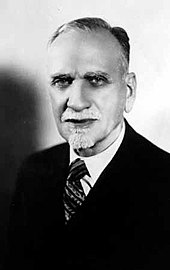Hashim al-Atassi
Hashim Chalid al-Atassi ( Arabic هاشم خالد الأتاسي, DMG Hāšim Ḫālid al-Atāssī ; * 1875 in Homs ; † December 5, 1960 ibid) was a Syrian statesman. He was an interim premier in 1920 and later three times President of the Syrian Republic with several years' interruptions : 1936–1939, 1949–1951 and 1954–1955.
youth
Hashim al-Atassi was the son of a large landowner and was raised in Istanbul . At the turn of the century he began his political career in the Ottoman province of Beirut .
Political activity
After Turkey's defeat in World War I, al-Atassi became a member of the Syrian Congress, which declared independence under the constitutional monarchy of Faisal I. In 1920 he became Prime Minister for a short time until the country was occupied by France at the end of 1919 under the League of Nations mandate for Syria and Lebanon .
As one of the political leaders who opposed the occupation, he was imprisoned by the French for a few months on the island of Arwad . After his release, he was involved in the negotiations for a Franco-Syrian treaty that was supposed to ensure Syria's independence and was signed on September 9, 1936 as a "friendship and alliance treaty".
After holding parliamentary elections, al-Atassi was elected the first president and thus head of state of modern Syria on December 21, 1936 . In 1939 he resigned from his post to protest against the incorporation of Hatay State into the territory of Turkey. Hatay had been part of Syria until 1938 as Sanjak Alexandrette and was given to Turkey by France to ensure its neutrality in the event of a conflict with Germany . The French high commissioner then suspended the constitution and ruled with emergency powers.
In 1949 al-Atassi became Prime Minister and President of Syria after the overthrow of Husni az-Za'im . With the support of the de facto ruler of Syria, Sami al-Hinnawi, the chief of staff of the Syrian army , al-Atassi wanted a union with Hashemite Iraq. After the coup of Adib al-Shishakli , who strictly opposed this association, al-Atassi remained president until the arrest of Prime Minister Maarouf al-Dawalibi in 1951, but had little influence. In another coup d'état, Shishakli was overthrown in February 1954, and Atassi returned to power. After free elections, Schukri al-Quwatli succeeded him as president in 1955 .
Individual evidence
- ↑ Dalal Arsuzi-Elamir: Arab Nationalism in Syria. Zakī al-Arsūzī and the Arab national movement on the periphery of Alexandretta / Antakaya 1930–1938. (= Studies on the Contemporary History of the Middle East and North Africa , Volume 9), Münster 2003, ISBN 3-8258-5917-7 , p. 144.
- ↑ Dalal Arsuzi-Elamir: Arab Nationalism in Syria. Zakī al-Arsūzī and the Arab national movement on the periphery of Alexandretta / Antakaya 1930–1938. (= Studies on the Contemporary History of the Middle East and North Africa , Volume 9), Münster 2003, ISBN 3-8258-5917-7 , p. 191.
| personal data | |
|---|---|
| SURNAME | Atassi, Hashim |
| ALTERNATIVE NAMES | Atassi, Hashim Chalid al-; Atassi, Hashim Khalid al- |
| BRIEF DESCRIPTION | Syrian statesman |
| DATE OF BIRTH | 1875 |
| PLACE OF BIRTH | Homs |
| DATE OF DEATH | 5th December 1960 |
| Place of death | Homs |


